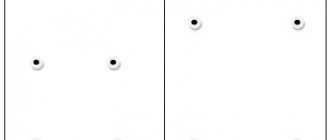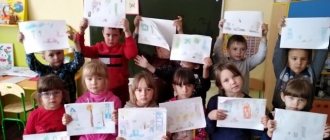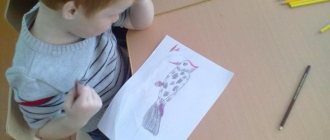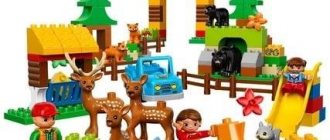Summary of the joint activity “The House Where I Live”
“Physical development” section “Physical education” - physical minute “Building a house”.
Types of children's activities:
game (playing out the building);
communicative (communication and interaction with adults and peers);
perception of fiction (reading a poem);
cognitive and research (object of the surrounding world “house”);
construction from building material (building a “house”);
motor (physical exercises);
basic household chores (after playing, put away building materials and toys).
Target:
“Creating conditions for the development of interest in constructive-model activities through a tabletop builder with subsequent playing out of buildings.”
Tasks:
Educational:
continue to lead to the analysis of the building ( two bricks stand close to each other on the left on narrow edges, two identical bricks stand on the right, two prisms on top, bricks in front and behind, placed with wide edges
);
help children use nouns with prepositions (on, for, in), adverbs (in front, behind, above, left, right);
continue to teach children to distinguish and name the essential parts of the house (walls, roof, windows, doors), materials and their properties (built of brick; wooden doors, solid walls, etc.)
Educational:
develop children's interest in constructive activities through a tabletop builder using small toys and crafts made from natural materials;
develop the ability to independently, without showing methods of action, construct buildings with free internal space (“house”).
Educational:
teach children to be polite (teach them to say hello, say goodbye, thank you for their help); interact and get along with each other in a short game together;
teach children to put away tabletop builders and toys after playing.
Methods and techniques:
practical - greetings accompanied by movements; physics lesson, construction of buildings from a tabletop builder;
visual – demonstration of illustrations;
verbal - questions that require statements (such as “How?”, etc.), questions that stimulate mental activity (such as “What do you think?”, etc.), conversation, explanation, reading a poem;
gaming - an imaginary situation, playing out buildings; d/ game “Whose house?”
Preliminary work:
looking at family photographs, illustrations on the topic “Houses are different”;
reading fiction (see the appendix to the program “From birth to school”);
plot-role-playing games: “Family”, “Daughters - Mothers”, “We are builders”;
d/games: “Who has what house?”, “Whose house?”;
Summary of a lesson in visual arts on the topic: “The house where I live”
Summary of a lesson in visual arts on the topic: “The house in which I live.” Preparatory group
Goal: To develop a sense of patriotism in preschoolers by understanding such concepts as native nature, hometown Vyazemsky,
Objectives: To teach children to convey in drawing the shape of buildings and parts of a house, the variety of structures of city houses: multi-story narrow, low and wide. To cultivate patriotic feelings, interest in learning about one’s native city and its history. Instill love for your small Motherland. Promote aesthetic education. Practice drawing with crayons, pencils and felt-tip pens. Preliminary work. Working with parents, designing the photo exhibition “The House I Live In,” introducing children to the sights of the city of Vyazemsky. Materials: Colored crayons, pencils, paper, photographs of city streets in the city of Vyazemsky Progress of the lesson. Vos-l: “Do you hear the song of the stream - this is your homeland! You hear the nightingale’s voice - this is your homeland! Kindergarten where your friends are - this is your homeland! Your mother's hands, the sound of branches and the sound of rain. And the currants in the garden are also the Motherland!” In Russia, like in any other country, there is a main city - the capital. Guys, name the capital of our country (children's answers). Voss. :Fine! In what city is your home or kindergarten located? (children's answers) Voss: Well done! Yes, our city is called Vyazemsky, and we are residents of this city and they call us Vyazemtsy (children repeat). Vos: Our city is large and very beautiful (shows photos of city streets), our streets are different and beautiful in their own way, there are pharmacies, schools and kindergartens, shops on the streets. What attractions do we have? (children's answers: museum, city park, monuments, etc. the teacher shows a photo). Well done guys, tell me, do you know the name of the street where you live? (children's answers).Very good. That's how much interesting you know about our city. Voss: Now let’s do some physical exercise. One two three four five. (Children jump on the spot) Let's build and play. We are building a big, tall house. (They stand on their toes and stretch their arms up) We install windows and build a roof. (Show the window, the roof with your hands - clasp your hands above your head) What a beautiful house! (They extend their arms forward with an index gesture) An old gnome will live in it. (Squat) Voss: Guess my riddle and find out what we will draw today. Here is a huge noisy world. There are four hundred apartments in it. Five entrances, intercoms, glazed balconies (house) Vos: That's right, today you will draw the house in which you live. What shape are they? (children's answers). Houses can be tall and narrow, low and wide (the teacher shows illustrations). What elements does the house consist of? (children's answers). That's right, well done. Now you will draw the house in which you live. Then we will put together a street of our city from your drawings. Children draw on their own. The teacher helps those who find it difficult. The finished drawings are arranged in the form of a street. Vos: Guys, I invite you to look at your drawings, you did your best and your street turned out very beautiful.
Get text
Summary of the lesson “The House I Live In” for the senior group
Summary of the lesson “The house where I live” for the senior group
Target
: Summarize and systematize children’s knowledge about their home; clarify knowledge about your place of residence; Teach children to make a whole from parts.
Tasks:
Educational field "Social and communicative development"
- create conditions for the formation of kindness, friendliness, goodwill.
Educational field "Cognitive development"
- consolidate knowledge about parts of the house; — improve different types of attention, memory, logical thinking; - expand and enrich children’s knowledge about human housing;
Educational field "Speech development"
- practice the formation of complex adjectives; — replenish the active dictionary with antonyms; — improve children’s ability to solve riddles; — teach children to answer questions based on a plot picture; — develop free communication with peers and adults; - continue to expand and activate your vocabulary;
Progress of the lesson
Educator:
Guys, today we have gathered to play a little. But this game is not simple, we will learn by playing. Listen to the poem:
- They say there was such a case somewhere, people were driving home from work. As soon as we got there, suddenly - miracles: Everyone forgot their addresses. They are searching, worried, looking around, Residents are rushing about: “Where is our floor?” Everything is confused, everything is lost! Fortunately, this only happened in a fairy tale. I told you about this on purpose, Where do you live? Where was your house built? And are you familiar with the house?
Educator:
-What is this story about?
Children:
- About the house.
Educator:
Today we will talk about houses, what they are like, what they are made of, what material they can be built from.
Educator:
- There are different houses and they are called differently: wooden, brick, panel.
— How do you understand these names? (Children's answers.)
- Indeed, guys, you are right. Wooden houses are houses built from wood. - Brick - built from bricks - Panel - from blocks. — Houses can also be one-story or multi-story. How do you understand these names: one-story house, multi-story house? (Children's answers.) - That's right, a house consists of one floor, a multi-story house means it consists of two or more floors. -Please tell us what your house consists of? (roof, walls, window, doors, foundation). - What's in it? (It has rooms and furniture). - Now guess the riddles about which rooms we are talking about:
We brush our teeth, wash our hands, We take a bath in the evening, Every morning we are not bored, We just wash ourselves (Bathroom)
I always have a sweet dream at night In this room, And in the morning a ray of light sometimes wakes me up (Bedroom)
In this room, everyone is together. The family gathers. Sometimes to have fun. Sometimes to play. Everyone watches TV. Or reads a book (Living room, hall)
This room welcomes everyone who comes to our house (Hallway)
Educator:
Guys, you are great! All the riddles have been solved!
- Guys, how should you treat your home so that it has order and comfort? How do you help adults with this? (Children's answers).
- Well done! You will become wonderful helpers!
4. Physical school
There is a house in a clearing (The fingers of both hands make a “roof”).
Well, the path to the house is closed.
(Hands turned with palms to the chest, middle fingers touching, thumbs up - “gate”)
We open the gate (Palms turn out).
We invite you to this house.
("Roof").
Educator:
and now let’s play with you the game “Say it backwards”:
- My house is high, and my house is (low) - My house is light, and my house is (dark) - My house is one-story, and my house is (multi-story) - My house is big, and my house is (small) - My house is old, but my house (new) - My house is on the left of the road, and my house is on (the right of the road) - My house is on a wide street, and my house is on (narrow street)
Educator:
and now we will learn and analyze the meaning of the most famous proverbs and sayings about home
"My home is my castle"
A fortress is a strong and reliable structure that prevents enemies from entering the property. This is how a home is a support for a person, because at home they will always support, help and listen.
“It’s good to be away, but it’s better to be at home.” When you come to visit, they always set the table and bring out treats, that’s why they say that it’s good to be away. But when you try all the treats, talk with the owners of the house, dance, have fun, you get tired and are drawn to your home, that’s why they say that home is better
“Like the owner, so is the house.” It is often said that by the house and its condition you can determine what kind of owner it has. When a house is neat and tidy, it means that it has a good owner who looks after his house, cares for it and loves it. If a house is falling apart and there is no harmony in it, then this means that its owner is mismanaged, a slob.
Lesson summary:
— Guys, tell me, what kind of houses are there? (wooden, brick panels). - What kind of rooms are there at home? (kitchen, bedroom, living room). — What are the names of the houses where people live? (dwelling). — What sayings and proverbs do you remember?
Well done guys, you answered very well in today's lesson.




